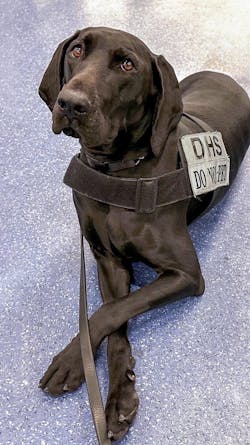Harry Reid International Airport Canine Dina Voted TSA’s Cutest Canine of 2023
Dina, a 3-year-old German Shorthaired Pointer (GSP) explosives detection canine at Harry Reid International Airport (LAS), is the winner of the Transportation Security Administration’s (TSA) 2023 Cutest Canine Contest.
Last week, TSA held a nationwide social media contest on Instagram, X (formerly known as Twitter) and Facebook, where the public voted for the agency’s “cutest canine” from among four agency finalists. TSA handlers from airports across the country initially nominated the dog candidates. TSA employees then voted and narrowed the original field of 92 contenders to the final four canines, all of whom deserve a round of a-paws.
Dina will be featured on the front cover of TSA’s 2024 canine calendar, which will be released later this year. The contest was held in recognition of National Dog Day to acknowledge the important role TSA’s hardworking canines play in protecting the nation’s transportation systems.
She is a passenger screening canine (PSC) who works alongside her handler, Nick Goyak, at LAS, where they provide explosives detection capabilities as an important layer of security. Dina has worked for TSA for 15 months and is paws-itively adorable. Dina is all-black, a rarity for a GSP, and is often misidentified as a black Lab.
Fun loving and attention seeking, Dina is a pup who wants to be everyone’s best friend. She loves to have her velvety ears rubbed and works hard to be rewarded with her favorite toy – a yellow tennis ball. Dina was one of several TSA canines who worked at Super Bowl LVII in Phoenix earlier this year to keep the venues safe and secure for football fans.
This is the second cutest canine winner in the last three years for LAS. In August 2021, TSA announced Alona, then a 4-year-old Golden Retriever and explosive detection canine, was the winner of the 2021 TSA Cutest Canine Contest. Alona and her handler continue their work at LAS.
TSA employs canines like Dina in its security operations nationwide. These teams nimbly work through large groups of people to detect the source of an explosives odor, even if the source is mobile. The dogs and their handlers train regularly, and the handlers learn to read their dog’s change of behavior when an explosives scent has been detected.
If a dog alerts its handler to the presence of an explosives odor, TSA follows an established procedure to resolve the alarm. The use of these highly trained canines is an effective tool in deterring and detecting the introduction of explosive devices into the nation’s transportation systems.
TSA has more than 1,000 canine teams that are trained at TSA’s national Canine Training Center in San Antonio, Texas. The National Explosives Detection Canine Team Program began in 1972 under the FAA as a partnership with state and local law enforcement. The program was transferred to TSA after the attacks of September 11, 2001, and the creation of TSA. The first use of TSA handled explosives detection canines was in March of 2008 to screen air cargo. In 2011, TSA expanded its canine program to screen passengers. As a reminder to travelers, TSA explosives detection canines are on duty while with their handlers at the airport and must not be petted. They are hard at work ensuring the safety of the traveling public.
Congratulations to our other three finalists, who included:
• Zita, German Shorthaired Pointer, from Minneapolis-Saint Paul International Airport (MSP)
• Zeta, German Shepherd, from Tampa International Airport (TPA)
• Joker-Jordan, Belgian Malinois, from Hartsfield-Jackson Atlanta International Airport (ATL)
Later this year, TSA will announce the availability of its free downloadable 2024 Canine Calendar, featuring 12 contestants from TSA’s 2023 Cutest Canine Contest.



